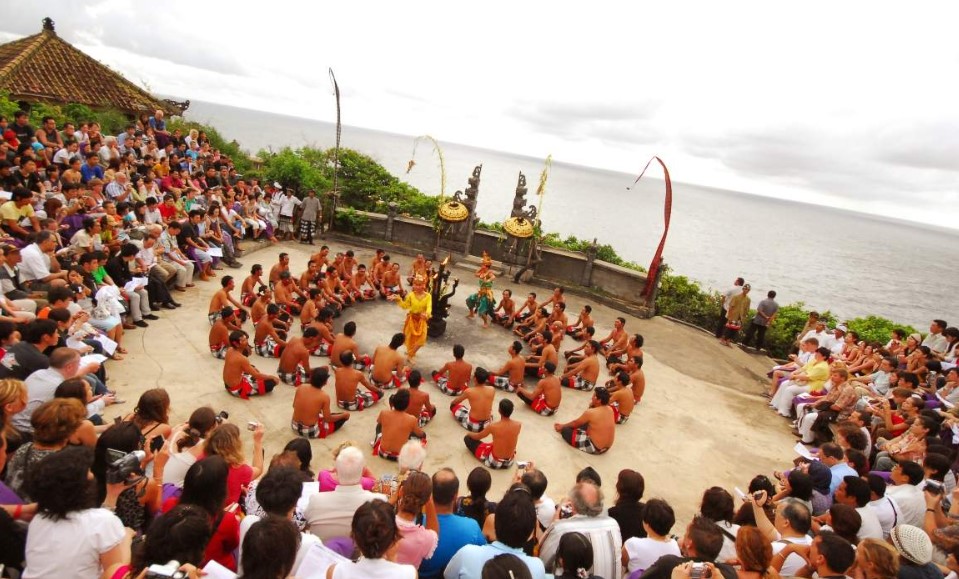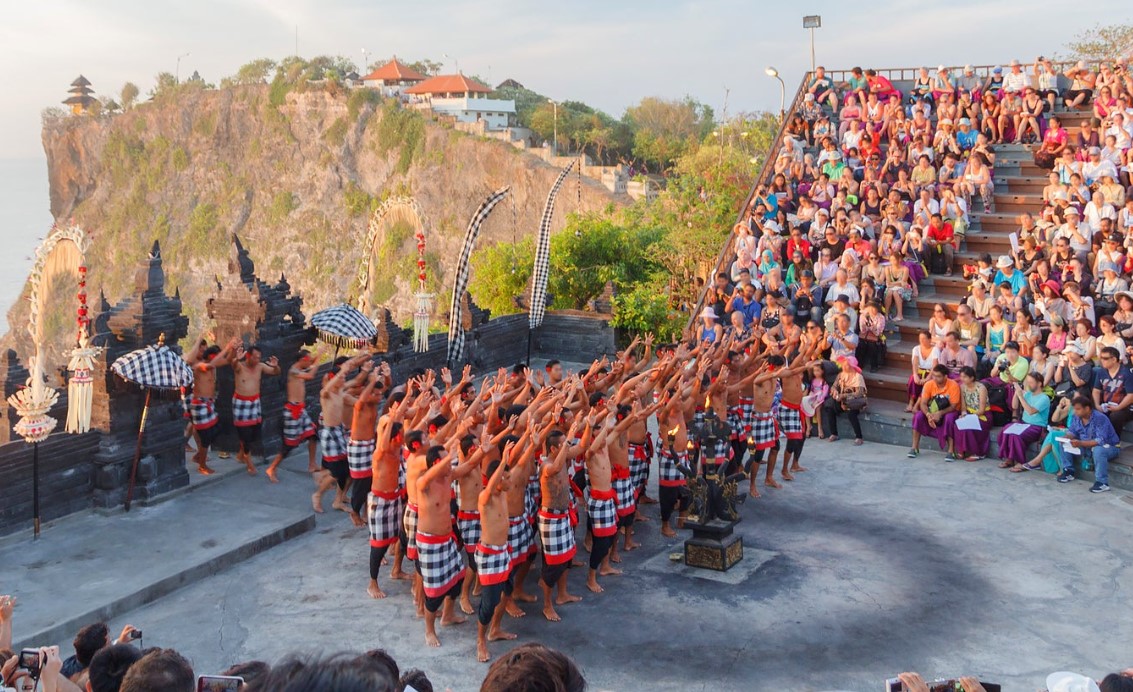Kecak dance (also known as the “Ramayana monkey chant”) is a traditional Balinese dance performed for centuries. It is a unique form of dance that combines chanting, singing, and movement to tell a story.
The dance is performed by a group of men who sit in a circle and chant “chak” (or “cak” in some other transcriptions) while waving their hands and arms in the air.
Besides being a beautiful art form, it has great cultural and historical importance to the Balinese Hindu people.
In this article, we’ll delve deeper into the history of Kecak dance, and all the other interesting facts about it, such as the costume, the music, and of course – where to watch it if you visit Bali!
Table of Contents
What Is Kecak Dance?
The Kecak dance is a unique Balinese dance form. In it, the dancers (all males) sit in a circle around a central platform, humming and chanting the word “chak” in unison.
If you ever get the opportunity to see a performance, the trance-like atmosphere that the humming and chanting create can be incredibly mesmerizing and captivating.
The Kecak dance is often performed as a retelling of the Hindu epic, Ramayana, which is told through the movements and gestures of the dancers.
To further bring each character to life, the dancers typically wear traditional Balinese costumes and masks as they perform on the stage.
The dance is typically accompanied by the sound of the gamelan, a traditional Balinese orchestra.
Check more: What is Kathak Dance?
Kecak Dance History: Who Invented The Kecak Dance
The Kecak dance has been a religious ritual in Bali for decades as a “trance ritual” by male choruses in the local community.
In the 1930s, a German painter and musician named Walter Spies visited the island nation and was instantly taken by the beautiful ceremony. He adapted the ceremony and turned it into a drama based on the Hindu Ramayana lore, meant to be performed in front of Western tourists.
Walter collaborated with Wayan Limbak, an Indonesian dancer, to bring the show abroad. This is how the Kecak dance became known to the international audience.
There are a lot of opinions and controversies around this.
For once, the adaptation of traditional culture using Western values didn’t sit well with a lot of art critics, who consider this an overstepping of the West to Eastern traditional norms. Meanwhile, others like the new developments and consider it an artistic innovation by Spies.
In any case, the Kecak dance has become a staple of the Balinese tourism industry. It’s also become an appreciated art form in many other countries outside of the beaches of Bali.
Read more: When Was The Jota Dance Created?
What Does The Kecak Dance Represent
A Story Of Prince Rama & His Wife Sita
The Kecak dance is rooted in the Ramayana, an ancient Hindu epic that tells the story of Prince Rama and his quest to rescue his wife Sita from the demon king Ravana.
The story – and the dance, by extension – is often seen as a celebration of good triumphing over evil, with Prince Rama representing virtue and Ravana representing vice.
Through the movements and gestures of the dancers, the story is brought to life and the audience is taken on a personal journey through the epic tale.
Even Western audiences who don’t understand the language of the locals can easily follow along and understand what the story is about at every turn: the stories are told mostly through movements and gestures.
A Communal & Spiritual Experience
Beyond its storytelling aspect, the Kecak dance also represents a spiritual and communal experience. The repeated chanting of the “kecak” sound is said to create a trance-like state for both the performers and the audience. It’s often said that the chant has a purifying effect on the mind and spirit.
And last but not least, as it’s always performed by a large group of dancers, the dance highlights the importance of community and cooperation in Balinese culture very well.
The way that the dancers move and chant in sync with one another creates a powerful sense of unity and harmony.
How Kecak Dance Is Performed
50-100 Dancers For A Performance
The Kecak dance is a unique form of dance that is performed by a large group of male dancers, typically numbering between 50 to 100 performers.
The dancers wear nothing on their bodies save for a loincloth, and their upper chests bared to the air.
On stage, the performers form concentric circles around a traditional Balinese coconut oil lamp.
When the show starts, the dancers will move their bodies rhythmically to the left and right while continuously chanting the words “chak ke-chak ke-chak ke-chak” in sync with each other.
The chanting is the most distinguishing aspect of this dance and it’s quite special among all the folk dances out there.
The Kecak is one of the very few dances where the “music” is made up of the human voice through chanting. There are zero musical instruments to be found throughout the whole performance.
The chanting gradually speeds up and, in turn, the dancers raise their hands into the air, trembling as if calling out to a deity. And as the “story” is told, the Kecak chanters sing and chant in accordance with the mood and setting.
The performance lasts about an hour and takes the audience through the different stages of the Ramayana story.
It starts with Sita and Rama’s exile in the jungle of Dandaka and through all of the trials and tribulations in the myth, finally culminating in the epic battle between Rama and Ravana.
It’s here that the dance will come to a spectacular conclusion.
The Trance Fire Dance
Coconut husks are strewn all over the stage and set on fire. The dancer/actor that plays the character Hanuman is blessed by a priest before he starts to perform a trance dance.
In his trance, he dances through the fire of the burning coconut husks, kicking them around and flinging embers all across the stage. The scene has been described by many a viewer as simply “enthralling.”
And no need to worry, as he’s in a trance, the dancer actually feels no pain at all!
Kecak Dancers
Because they don’t have any distinguishing costumes that set them apart from others, it may seem to the untrained eyes like there’s no role or “type” to Kecak dancers at all.
In reality, there are two kinds of dancers: the Kecak male chanters and the main Ramayana dancers who portray the characters of the story.
The Kecak male chanters are basically like backup singers and dancers.
They make up the vast majority of the dancers, chanting “chak-chak-chak” in harmony and rhythmically in the background as they move their bodies to the left and right.
During the performance, some of the male chanters have specific tasks to maintain the chant’s beat and lead the chorus by yelling commands.
The senior male dancers are usually chosen for these tasks, which include singing during the chanting and narrating the story in Balinese and Sanskrit.
But the spotlight of the show is the main cast, which is played by both male and female dancers.
Female dancers, distinct from the rest of the cast with their smoother and more graceful movements, play female characters such as Sita, Rama, Lakshmana, and the Golden Deer.
Meanwhile, male dancers play masculine and muscular characters, such as Ravana, Hanuman, and Sugriva.
The Kecak dance is not only a musical and theatrical performance but also a cultural tradition. Dancers come from the surrounding villages and hold side jobs outside of their dancing careers.
They rehearse the performance and prepare themselves before every show, which usually takes place daily in the evening at Balinese Hindu temples or other designated dance stages.
Kecak Dance Music
The Kecak dance is distinctive as it features no musical instruments.
The only sound you’ll hear from the beginning to the end of the show is the chanting of the bare-chested male chanters on the stage. It’s how the dance got its name in the first place!
Where To Watch Kecak Dance Performances In Bali
Kecak dance shows are performed in Balinese Hindu temples such as Uluwatu Temple and Tanah Lot. Shows typically take place at dusk at around 6 PM.
Other venues for Kecak performances include dance stages in Ubud, Garuda Wisnu Kencana, Batu Bulan, Pandawa Beach, and other places in Bali. You can find more information online or ask your travel agent if they can get you a ticket to one of these shows.
However, out of all these destinations, the Uluwatu Temple is possibly the most popular destination for Kecak dance performances.
Final Words
If you’re ever in Bali, a Kecak dance performance is something that you won’t want to miss. It’s the perfect blend between the folkloric dance traditions and religious mythology of the people of Bali.
The dance has served to attract thousands of visitors from around the world to come by the island and see the enchanting performance for themselves.
There’s a good chance that you’ll be one of the many who leave the performance with an awe-stricken smile, too!


